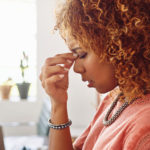Since May is Melanoma Awareness Month, we’re devoting this blog to educating our readers about one of the most deadly cancers: melanoma. In it, we’ll discuss melanoma’s causes and how you can prevent it.
Melanoma diagnoses are increasing at epidemic rates. According to the American Academy of Dermatology, more than 1 million Americans are currently living with melanoma, and nearly 200,000 more new cases of melanoma are expected to be diagnosed.
For people aged 15 – 29, melanoma is the second most commonly diagnosed cancer. In addition, melanoma is the leading cause of cancer death in women aged 25 – 30, and is much higher in lighter skin people: 1 in 40 for Caucasians, as compared to 1 in 200 for Hispanics and 1 in 1,000 for African Americans.
So what causes melanoma, exactly?
Melanoma occurs when something goes wrong in the melanin-producing cells (melanocytes) that give color to your skin. Healthy new skin cells typically push older cells toward the skin’s surface where they die and fall off. However, when some cells develop DNA damage, new cells may begin to grow out of control and can eventually form a mass of cancerous cells called melanoma.
What causes DNA damage isn’t totally clear, but experts believe it is likely a combination of factors, including environmental and genetic factors. But according to the Melanoma Research Foundation, a whopping 90 percent of melanomas are thought to be caused by exposure to ultraviolet (UV) radiation from the sun and tanning beds
Unfortunately, all it takes is one blistering sunburn – especially when you’re young – to more than double your chance of developing melanoma later in life.
What About Tanning Beds?
If you are still using tanning beds after all the information that has been uncovered about their dangers, you need to do a radical rethink.
Indoor tanning beds have been proven to cause skin cancers like melanoma and have been classified into the highest cancer risk category by the World Health Organization’s International Agency for Cancer Research.
Exposure to tanning beds before age 30 increases a person’s risk of developing melanoma by 75 percent! Young people who regularly use tanning beds are eight times more likely to develop melanoma than people who have never used them.
Risk Factors
- Fair skin. When you have less pigment (melanin) in your skin, you have less protection from damaging UV radiation. If you have blond or red hair, light-colored eyes, and freckle or sunburn easily, you’re more likely to develop melanoma than is someone with a darker complexion. But melanoma can develop in people with darker complexions, including Hispanics and blacks.
- A history of sunburn. One or more severe, blistering sunburns can increase your risk of melanoma.
- Excessive ultraviolet (UV) light exposure. Exposure to UV radiation, which comes from the sun and from tanning lights and beds, can increase the risk of skin cancer, including melanoma.
- Living closer to the equator or at a higher elevation. People living closer to the earth’s equator, where the sun’s rays are more direct, experience higher amounts of UV radiation than do those living in higher latitudes. In addition, if you live at a high elevation, you’re exposed to more UV radiation.
- Having many moles or unusual moles. Having more than 50 ordinary moles on your body indicates an increased risk of melanoma. Also, having an unusual type of mole increases the risk of melanoma. Known medically as dysplastic nevi, these tend to be larger than normal moles and have irregular borders and a mixture of colors.
- A family history of melanoma. If a close relative — such as a parent, child or sibling — has had melanoma, you have a greater chance of developing a melanoma, too.
- Weakened immune system. People with weakened immune systems, such as those who’ve undergone organ transplants, have an increased risk of skin cancer.
* Source: MayoClinic.org
How To Protect Your Skin
The following tips can help you protect your skin from too much UV exposure:
- Stay in the shade as much as possible whenever you’re outdoors.
- Cover up your vulnerable skin with clothing, sunglasses, and a wide-brimmed hat.
- Try to avoid being in the sun between 10 a.m. – 4 p.m. when the sun is at its strongest.
- Use a broad-spectrum sunscreen with SPF of at least 30 and reapply every two hours.
If you suspect you may be a higher risk for melanoma, or if you have a suspicious mole that you would like to have checked out, click here to schedule an appointment.
Dermatology Associates offers a full spectrum of leading-edge medical, surgical, and cosmetic dermatology services from offices in Savannah and Vidalia.


